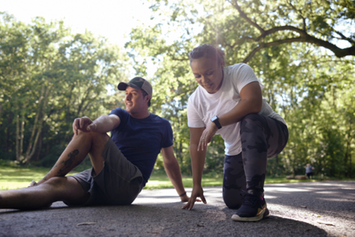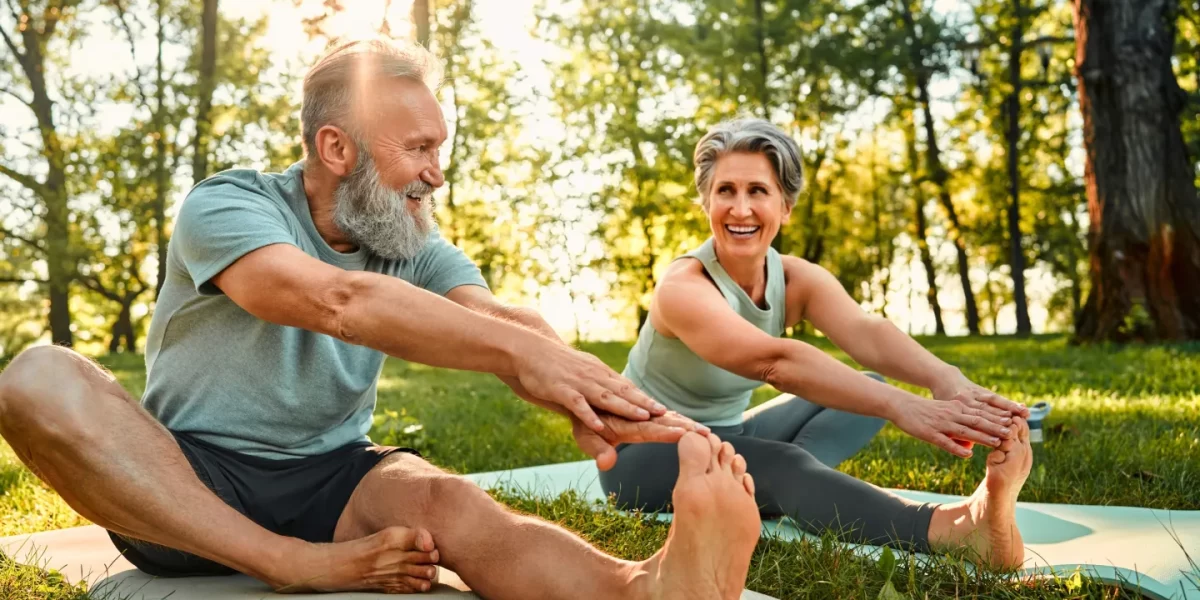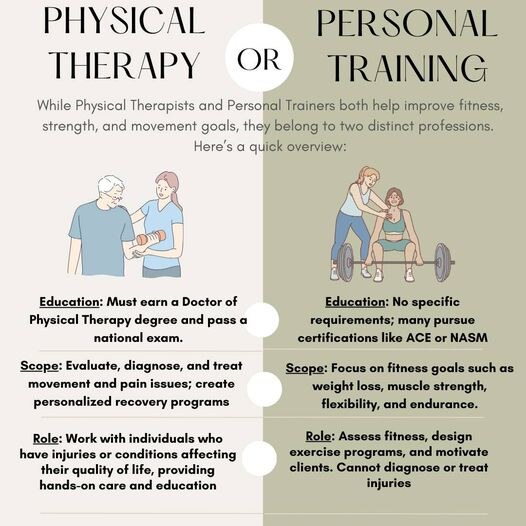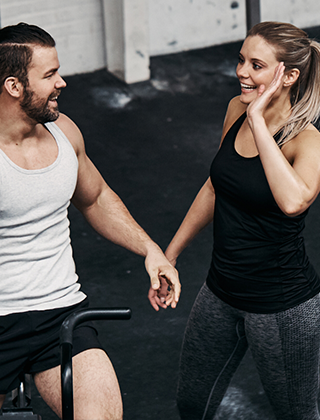Spring is in the air, even in those parts of the country that have seen freezing winter storms. With warmer weather comes a desire to get outside, get active, and shed some of the weight with a spring fitness plan that might have been gained during winter months.
Exercising alone or only with your partner is still a great way to make good on your spring fitness goals while enjoying the nice weather.
Get the full effects of Spring fitness
Did you know that exercising regularly affects more than just physical fitness? You might be surprised to discover that exercise makes you more likely to:
- Live longer
- Sleep well at night
- Be in a good mood
- Control your weight
The Fitness Zone has five tips to help you put your best foot forward when you’re keeping fit in the heat.
1. Warm-up and cool-down
Always include a warm-up and cool-down as a part of your exercise routine. A tough workout can lead to muscle strain and injury if your body does not ease in and out of physical activity. Include stretching after your cool-down routine to increase flexibility. Muscles will still be warm and more flexible, which will allow you to move through a fuller range of motion.
2. Wear proper footwear
It’s important to choose the right clothing and footwear. Both should be comfortable and safe. You might think that your flip-flops or slippers are the most comfortable shoes you own, but they are not appropriate for working out. For exercising, be sure to have properly fitted athletic shoes with good arch support. The right shoes will prevent too much stress on your feet and knees and will help you from stumbling on obstacles in your path.
3. Don’t overdo it
For many Veterans, starting a brisk walking program may be more appropriate than running at full speed. Begin by taking it easy on your joints and work your way towards finding the point at which you are challenged. Remember: you’re not a new recruit doing physical training in basic training anymore. Get into your workout program step by step to avoid injury and burnout. And keep in mind, if you’re training outdoors, you always need to get back home. So be careful to pace yourself and don’t go too far in one direction.
4. Track progress
Setting concrete goals and tracking your progress in achieving those goals can be a great motivator. Keep the goals realistic. For example, don’t start your running program by running long distances. As you keep track of your exercise, you will notice your exercise patterns. With those records, you’ll recognize how much progress you’re making, or if your success is dropping off.
5. Drink enough liquids
Working out in the heat and humidity can put you at risk for dehydration, heatstroke, and other heat-related illnesses. The easiest way to avoid heat disorders is to keep your body hydrated. This means drinking liquids before, during, and after your exercise.
Don’t drink the kind of soda or fruit juices that will only make you more dehydrated. Choose water or a low-calorie sports drink. Insufficient liquids will not just leave you feeling uncomfortable, but dehydration can lead to fainting or muscle cramps.

Staying fit should incorporate mental and emotional fitness as well.
Dr. Bill Dorfman, a 64-year-old cosmetic dentist in Southern California, prides himself on looking years younger, a characteristic he attributes to good genes and a daily workout regimen that helps staying fit
Three days a week he focuses on abs and cardio; the other days are for lifting light weights at high reps.
Dorfman says he got serious about exercise following a lull during dental school when he found himself frequently in pain. That’s when he realized his fitness had taken a back seat following years as a high school swimmer and gymnast. “What I found was the more I exercised, the better I felt,” he says.
Outside of the gym, he credits his daily Words With Friends habit with keeping his mind sharp. He also makes nightly dinner plans with various friends to stay connected.
Dorfman’s wellness habits underscore that one key to a longer life is a fitness regimen—but one that incorporates mental and emotional fitness as well.
“We really need to look at the life of an older adult with a holistic lens—if they’re really happy, healthy, and whole,” says Dor Skuler, cofounder and CEO of Intuition Robotics and an expert on loneliness in aging adults.
Here are four ways to focus on whole-body fitness as you age.
1. Exercise for the body and brain
Staying physically active and staying fit can prevent injuries and help the body heal faster when they happen, plus it’s also strongly linked to good mental health and brain function.
Kirk Erickson, PhD, director of Translational Neuroscience at AdventHealth Central Florida, where he studies the plasticity and modifiability of brain systems, has found physical activity to be one of the best ways to keep the brain healthy throughout its lifespan.
Erickson’s research shows that as we age, the brain shrinks, specifically the hippocampus, which is responsible for memory formation. Exercise can help maintain this portion of the brain and, in some cases, increase the size. There’s much to be learned about how and why this is, but Erickson says the effects are better the longer you engage in these habits, so it’s good to start young.
Of course you can still reap the benefits if you start later in life, he says. You might find that with time, you can recall memories and information more easily and have better executive function and a longer attention span when your brain is at its best, he says.
He recommends moderate exercise, like walking, five days a week for 30 minutes.
Aside from walking, Dr. Gary Small, chair of psychiatry at Hackensack Meridian Health, says strength training helps combat age-related muscle loss and can lead to a longer lifespan. Additionally, balance exercises can help prevent slips and falls—the leading cause of injuries in adults ages 65 and older.
Jasmine Marcus, a physical therapist at Cayuga Medical Center in Ithaca, N.Y., where she works with patients of all ages and physical activity levels, recommends tiptoeing into exercise if you’re new to it. She suggests starting with some kind of group fitness class like Zumba—anything that elevates your heart rate. It helps, too, if you have a partner to hold you accountable, she says.
2. Strive for mental fitness
Small also recommends doing activities that keep the brain in shape. One study showed the simple act of reading articles online and searching topics on Google offered valuable mental stimulation. Doing crossword puzzles, reading books, playing games, practicing hobbies, and daydreaming all contribute to mental sharpness and staying fit.
Stress management is also a critical part of maintaining mental fitness. Just 10 minutes of meditation a day can improve mood and cognitive agility, says Small, rewiring the brain and strengthening neural circuits.
“You don’t have to go to a retreat in Nepal or India to meditate, but you can learn the skills,” he says.
3. Stay social
The U.S. surgeon general issued an advisory last year warning of the nation’s loneliness epidemic, which negatively impacts health. One study equated lack of social connection to smoking up to 15 cigarettes a day. Other studies show social connection reduces the risk of premature death. It’s clear that social and emotional fitness is key to aging well and staying fit.
Skuler, whose company makes AI-powered social companions for aging adults aimed at keeping them active and engaged, says major life changes, such as the death of a spouse, often trigger loneliness.
“That is by far a watershed moment,” he says. Suddenly no one is asking how you slept or what you have planned for the day. A similar problem happens with asynchronous aging, where one spouse has a decline with dementia, for example. Other events such as retiring or sending the kids off to college might have similar impacts on social well-being, Skuler says.
ElliQ, the robot companion Skuler’s company makes, is one way to help aging adults stay connected, but he encourages all people to maintain friendships and relationships with family members. Volunteering, he says, can also add purpose and connection to your life.
4. Develop good sleep hygiene
There’s a myth that seniors need less sleep as they age, but Jamie Zeitzer, PhD, advisor and scientific reviewer at Rise Science, says the reality is sleep becomes more difficult with age. The result is that many seniors find themselves going to bed later and rising earlier.
“Humans are programmed to stay awake 16 [hours] and sleep eight hours,” he says. “An older person’s ability to do that diminishes, so they have to work a little harder at it.”
The causes for poor sleep can be both social and physical. We become more sensitive to sounds and temperatures as we age, says Zeitzer. So the garbage truck that never woke you on its weekly route might now rouse you at 6 a.m., he says. Similarly, a bedroom that’s too hot or cold might make it difficult to sleep.
As we age we also become more sensitive to caffeine. So if you used to be able to drink a cup of coffee in the evening, you could find you now have trouble falling asleep hours later.
There’s also a major shift that happens once we retire, when the social constraints around sleep are suddenly lifted. Seniors who don’t have social obligations early in the morning might find they’re less inclined to sleep at typical hours. A nap during the day, for example, may “cannibalize their sleep at night,” Zeitzer says.
Older adults might find that sleeping too little or having a fragmented night of sleep can lead to acute problems with cognition the following day, Zeitzer adds. Poor sleep over the long term is linked to health conditions including depression, Alzheimer’s disease, and cancer.
A good routine can solve some sleep problems. To start, avoid caffeine later in the day. And be mindful that you adjust the temperature in your sleep environment to encourage rest and staying fit..
And he recommends finding a way to wind down before bed. While some experts warn against the use of electronics before you grab some shut-eye, Zeitzer says watching a TV show can be helpful if it means you feel more relaxed and ready for bed afterward.
“It’s always good to aspire to closing your eyes and falling asleep, but other people need more kinds of wind-down routines,” he says.
Physical therapy and personal training both play essential roles in helping people improve their fitness, strength, and movement. While they belong to distinct professions with different scopes of practice, education, and training, both can work together to offer comprehensive care and achieve optimal health outcomes. Understanding their differences and how they complement each other can help you make informed decisions about your health and wellness journey.
The Role of Personal Training
Education and Certification: Personal trainers are fitness professionals who work one-on-one with clients or in small groups to achieve specific health and fitness goals. While there are no specific educational requirements to become a personal trainer, many pursue certifications from accredited agencies such as the American Council on Exercise (ACE) or the National Academy of Sports Medicine (NASM). Certifications in first aid and the use of an automatic external defibrillator (AED) are also commonly required.
Scope of Practice: Personal trainers focus on:
- Assessing a client’s fitness level.
- Designing customized exercise programs to achieve goals such as weight loss, muscle strengthening, flexibility, endurance, and improved sports performance.
- Instructing clients on the safe use of exercise equipment and proper exercise techniques to avoid injury.
- Motivating and supporting clients to stick to their programs.
Personal trainers cannot diagnose injuries or health conditions or prescribe rehabilitation programs. Instead, they work alongside clients to enhance their fitness levels and overall health.
The Role of Physical Therapists vs Personal Training
Education and Certification: Physical therapists (PTs) are licensed health professionals who must earn a Doctor of Physical Therapy (DPT) degree from an accredited program, which typically takes three to five years to complete. They must pass the National Physical Therapy Examination and fulfill state licensure requirements. PTs also complete continuing education hours to maintain their licenses.
Scope of Practice: Physical therapists:
- Evaluate, diagnose, and treat movement and pain issues.
- Create personalized recovery programs to improve movement, reduce pain, and prevent disability.
- Treat a wide range of conditions, including back and neck pain, sports injuries, post-surgical healing, age-related issues, joint problems, and more.
- Use various tools and procedures, including hands-on treatment, stretches, exercises, and modalities such as heat or cold therapy, ultrasound, electrical muscle stimulation, and more.
PTs also teach clients home exercise programs to maintain progress and reduce the risk of re-injury after their in-clinic program ends.
How Physical Therapy and Personal Training Work Together
Combining the expertise of physical therapists and personal trainers can provide a comprehensive approach to health and fitness. Here’s how they complement each other:
1. Integrated Care: Physical therapists and personal trainers can collaborate to ensure a seamless transition from rehabilitation to fitness. After completing a physical therapy program, clients can continue working with personal trainers to maintain and further enhance their fitness levels.
2. Personalized Programs: Both professionals design personalized programs tailored to individual needs. A physical therapist can create a rehabilitation plan to address specific injuries or conditions, while a personal trainer can develop a fitness program to achieve broader health goals.
3. Prevention and Maintenance: Physical therapists help prevent future injuries by addressing underlying issues and improving functional mobility. Personal trainers focus on maintaining and building on these improvements, promoting long-term health and fitness.
4. Enhanced Motivation and Support: Working with both a physical therapist and a personal trainer provides clients with a well-rounded support system. Physical therapists offer medical expertise and rehabilitation, while personal trainers provide motivation and accountability to stay on track with fitness goals.
Why Choose The Human Performance and Wellness Center and The Fitness Zone?
At The Human Performance and Wellness Center and The Fitness Zone, we understand the importance of integrating physical therapy and personal training to provide the best care possible. Since 2007, we have been offering transformative physical therapy, personal training facility and other cash based services to clients of all ages. We also collaborate closely with certified personal trainers at The Fitness Zone, ensuring a holistic approach to health and wellness.
Our Commitment:
- Personalized attention and commitment to each client.
- Expertise of our highly trained staff.
- State-of-the-art facilities.
- Listening to client feedback and valuing their input to develop tailored plans.
We know how challenging it can be to perform even the smallest daily activities when experiencing pain and impaired movement. That’s why we work closely with our clients to develop personalized plans that meet their goals. By combining your knowledge of your body with our specialized training, we are confident in achieving optimum healing and improved function.
Conclusion
Both physical therapy and personal training offer unique benefits that can significantly enhance your health and wellness journey. By understanding their distinct roles and how they work together, you can leverage their combined expertise to achieve your fitness, strength, and movement goals.
At The Human Performance and Wellness Center, we are proud of the positive feedback we receive from our clients, highlighting how physical therapy has improved their lives. Contact us today to schedule a free screening and take the first step towards a healthier, more active life.
Building a Fairer, Healthier World
World Health Day is a global health awareness day celebrated every year on April 7th, under the guidance of the World Health Organization, as well as other related organizations.
This is a movement to build a fairer, healthier world. As COVID-19 has highlighted, some people are able to live healthier lives and have better access to health services than others, entirely due to the conditions in which they:
- Are born;
- Grow;
- Live;
- Work; and
- Age.

All over the world, some groups struggle to make ends meet with little daily income. They may have poorer housing conditions and education, fewer employment opportunities, experience greater gender inequality, and have little or no access to safe environments, clean water and air, food security and health services.
Health inequity is not only unfair, it is preventable. That is why the World Health Organization is calling on others to ensure that everyone has living and working conditions that are conducive to good health. At the same time, we urge leaders to monitor health inequities, and ensure that all people can access quality health services when and where they need them.
This Valentine’s Day themed circuit workout contains three circuits, each of which have three strength exercises (upper body, lower body, and core) which are done for 12 reps followed by one minute of cardio. Do the first four exercises, rest as needed, and then go onto the next circuit. Complete all three circuits 4 to 5 times for a full workout. This full body workout will work all your major muscle groups in less than an hour.
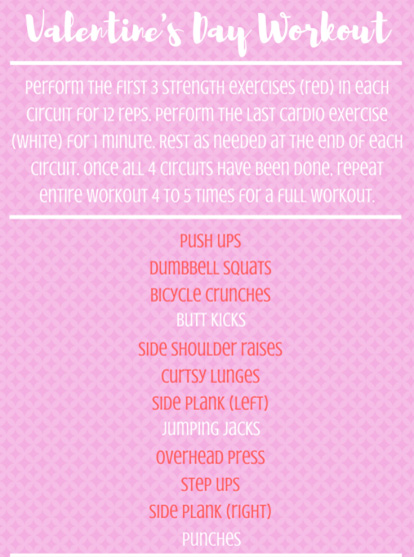
Push ups
Starting on your toes and hands, make sure your body is a straight line from your heels to your knees, hips, shoulders, and neck. Your hands should be a bit wider than your shoulders. Slowly bend at the elbows, lowering yourself to the ground. Try to get at low as possible, and then push yourself back up, all the while maintaining that straight line. An easier modification is instead of being on your toes, lower to your knees.
Dumbbell squats
With feet hip width apart and dumbells in your hands at your sides, use the glutes to lower your hips back and down while bending at the knees and ankles. Once you’ve reached the lowest position you can without leaning forward too much or letting the knees collapse in, return to a standing position, again using your glutes to propel yourself.
Bicycle crunches
Lay on your back with your knees bent and your feet flat on the floor. With your hands behind your head and elbows out to the side, bring your feet off the floor so that your shins are parallel to the floor and your knees are bent at a 90 degree angle. Bring your shoulder blades off the floor and alternate bringing your left elbow towards your right knee, and your right elbow towards your left knee. Your feet should look like they’re pedaling a bike.
Butt kicks
Stand with your feet hip width apart and your arms bent comfortably at the elbow. Bend your left knee and bring the heel of your left foot behind you so that it touches your butt. Lower your left foot back down to the ground and repeat with your right foot.
Side shoulder raises
With your arms down at your sides with a dumbbell in each hand, slowly raise your hands away from your body to the side, keeping your arm straight at the elbow. Once your hands reach shoulder level, slowly lower them back down to your sides.
Curtsy lunges
Similar to alternating lunges, instead of stepping straight back with your left leg, you place your left foot behind you and to the right, so that it crosses behind you and return to standing. Repeat with your right foot stepping back and to the left.
Side plank
To perform a side plank, lay on your side with your elbow beneath your shoulder and your forearm on the ground. With your top foot stacked on top of your bottom foot, lift your hips off the floor so that your shoulders, hips, knees, and feet are in a straight line. Hold and then repeat on the other side.
Jumping jacks
Stand with feet together and arms at your sides. Jump both feet apart from each other while raising your hands above your head with straight arms. Jump your feet back together and lower your arms to the starting position.
Overhead press
Stand with your feet hip width apart with a dumbbell in each hand. With your upper arms in a 90 degree angle to your torso and your hands directly above your elbows, lift your hands straight up so that your arms are straight above your head. Slowly lower your hands back down to the starting position.
Step ups
Find something that when you put your foot on it, your knee is at a 90 degree angle. This could be a chair or bench. Step up with your left foot, and pushing off that heel step your right foot off the floor and onto the bench. Immediately step back down with your left foot, followed by your right foot.
Punches
Stand with your feet hip width apart with your left foot slightly forward. Lift your arms up so that your hands are in front of your face with your left hand slightly forward. Punch one hand at a time in front of you, repeating as quickly as possible while maintaining good form.
This post contains affiliate links. Thank you for supporting my blog, I appreciate it!
As always, talk to your doctor before beginning to workout. Honor your body and modify this workout as needed.
Are you doing anything fun tonight for Valentine’s Day? Let me know in the comments.
Valentine’s Day isn’t just for chocolates and flowers. It also can be an excellent opportunity to get moving with this partner workout.
The holiday of love is actually in the top 10 of America’s most-fattening holidays.
So, that’s even more reason to break a sweat! Take your V-Day to the next level with this full-hour partner workout. Grab your valentine (or galentine), and let’s get to it!
WARM-UP
Timed Partner Workout Switches, 60 seconds each:
- Partner 1 doing Sweeping Good Mornings and Partner 2 doing Windmills, then switch.
- Partner 1 doing Squats and Partner 2 doing Push-Ups, then switch.
- Partner 1 doing Jacks and Partner 2 doing Lunges (any style), then switch.
- Partner 1 doing Squat Thurst Lite and Partner 2 doing Broad Jumps, then switch.
ROUND 1
Joint Partner exercises, 90 seconds each, then repeat the list of exercises before moving on to Round 2:
- Wheelbarrow Squats, where one partner is in a Push-Up position and the other partner is holding their feet. As the first partner does a Push-Up, the second partner then does a Squat. Switch halfway.
- Leg Pushes, where one partner is lying on his/her back with legs extended to the sky, while the other partner is standing over the first partner’s head. The standing partner then pushes the lying partner’s legs down repeatedly. Switch halfway.
- Plank Jump Overs, where one partner is in a High Plank position and then lowers down for a Hand-Release Push-Up. When the first partner is flat on the ground, the second partner hops or steps over him/her.
- Wall Sit + Tricep Dips, where one partner is in a Wall Sit position against a wall, while the other partner places his/her hands on the first partner’s knees to perform Tricep Dips. Switch halfway through.
- Squatted Ball Passes, where partners are in a Squat position back to back. Twist to pass a medicine ball or other weight to the other partner. Switch directions halfway through.
- Plank + Sit-Up, where one partner is lying on his/her back with feet flat on the ground, and the other partner is in a Plank position with his/her hands on the other partner’s feet. The lying partner then performs Sit-Ups or Crunches. Switch halfway.
ROUND 2
Counter-Switch Partner Sets, 5 minutes each set, switching back and forth when one partner completes the designated reps of one of the two exercises:
- Partner 1 starts with 20 Heartbeats, while Partner 2 starts with Jump Rope.
- Partner 1 starts with 20 Ribbon Squats, while Partner 2 starts with X-Country Skiers.
- Partner 1 starts with 20 Plank SeeSaws, while Partner 2 starts with Squat Jumps.
- Partner 1 starts with 20 total Side Lunges, while Partner 2 starts with Burpees.
- Partner 1 starts with 20 Kettlebell Halos, while Partner 2 starts with Fast Feet.
- Partner 1 starts with 20 V-Ups, while Partner 2 starts with Jacks.
ROUND 3
Partner Plank-Off, with both partners in their hardest level of a Plank, holding for as long as possible. The first one to come down has to make the other a refreshing protein recovery shake!
And don’t forget to stretch out afterward.
(Southern Italian Poached Fish)
Serves 4 TIME 35 minutes Cooks Country
WHY THIS RECIPE WORKS
“Acqua pazza,” or “crazy water,” refers to the southern Italian tradition of cooking the day’s catch in seawater “Pesce All’Acqua Pazza”. Modern recipes feature longer ingredient lists: Parsley, tomato, white wine, and garlic are common. For the fish, we chose skin-on haddock fillets. The flesh held up nicely during simmering, and the abundant collagen in the skin suffused the broth with rich flavor and body. Halved cherry tomatoes provided sweetness and pops of color. We also liked the addition of white wine, which contributed brightness and light acidity. After just a few minutes, the haddock absorbed the heady flavor of the broth and the broth was enriched by the fish.
Pesce All’Acqua Pazza INGREDIENTS
1½ pounds haddock fillets, ¾ to 1 inch thick (I used boneless, skinless Cod or Shrimp)
1 teaspoon kosher salt divided
¼ teaspoon pepper
2 tablespoons extra virgin olive oil
3 garlic cloves, sliced thin
¼ teaspoon red pepper flakes
1 small onion, chopped fine
1 bay leaf
8 ounces cherry or grape tomatoes (or Sugar Bombs), halved
1¼ cups water
¼ cup dry white wine (Dry Vermouth)
12 fresh parsley stems, plus 3 tablespoons chopped fresh parsley, divided
2 tablespoons capers optional
BEFORE YOU BEGIN
You can substitute skin-on fillets of other firm, white-fleshed fish such as branzino and red snapper for the haddock. Serve with crusty bread.
Pesce All’Acqua Pazza INSTRUCTIONS
Sprinkle haddock all over with ½ teaspoon salt and pepper and set aside.
Heat oil, garlic, and pepper flakes in 12-inch skillet over medium heat, stirring constantly, until garlic begins to sizzle gently, 1½ to 2 minutes. Add onion, bay leaf, and remaining ½ teaspoon salt and cook, stirring constantly, until onion just starts to soften, 2 to 3 minutes. Add tomatoes and cook, stirring constantly, until tomatoes begin to soften, 2 to 3 minutes. Stir in water, wine, parsley stems, and half of chopped parsley and bring to boil. Nestle haddock skin side down in liquid, moving aside solids as much as possible (it’s fine if fillets fold over slightly at ends; liquid will not quite cover fillets). Spoon some liquid and solids over haddock. Reduce heat to low; cover; and simmer gently until fish registers 110 degrees at thickest point, 4 to 7 minutes. Let stand off heat, covered, until fish is opaque and just cooked through (fish should register at least 135 degrees), 3 to 7 minutes.
Divide haddock among 4 shallow soup bowls. Discard bay leaf and parsley stems; stir remaining chopped parsley into broth. Season broth with salt and pepper to taste. Spoon portion of broth and solids over each serving of haddock and serve immediately.
Nutritional Information
Per Serving (Serves 4)
Calories 221 Total lipid (fat) 8 g Fatty acids, total saturated 1 g
Fatty acids, total trans 0 g Fatty acids, total monounsaturated 5 g
Fatty acids, total polyunsaturated 1 g Cholesterol 92 mg Sodium, Na 814 mg
Carbohydrate, by difference 5 g Fiber, total dietary 1 g
Sugars, total including NLEA 2 g Protein 29 g
Let’s clear up one common misconception from the get-go: Self-care is not synonymous with self-indulgence or being selfish. Self-care means taking care of yourself so that you can be healthy, you can be well, you can do your job, you can help and care for others, and you can do all the things you need to and want to accomplish in a day.
If you think you’ve been hearing more about self-care lately, you’re right. One indicator: According to Google Trends, the number of searches for “self-care” has nearly quadrupled since 2018.
Paula Gill Lopez, PhD, an associate professor in the department of psychological and educational consultation at Fairfield University in Fairfield, Connecticut, says the need is obvious. “We have an epidemic of anxiety and depression,” she says. “Everybody feels it.”
Self-care is part of the answer to how we can all better cope with daily stressors, explains Kelsey Patel, a Los Angeles-based wellness expert. It’s work stress. It’s the stress of trying to keep up with the pace of daily life, which technology has hastened more than ever (just think how many emails come flooding into your inbox each day). “People are feeling lonelier and less able to unwind and slow down, which makes them feel more anxious and overwhelmed by even the simplest tasks,” Patel says.
What Is Self-Care, and Why Is It Critical for Your Well-Being?
Several organizations and researchers take a health-oriented approach when defining self-care. The World Health Organization defines self-care as: “the ability of individuals, families, and communities to promote health, prevent disease, maintain health, and cope with illness and disability with or without the support of a health worker.”
According to this definition, it includes everything related to staying physically healthy — including hygiene, nutrition, and seeking medical care when needed. It’s all the steps an individual can take to manage stressors in his or her life and take care of his or her own health and well-being.
What Is Self-Care?
Self-care is anything you do to take care of yourself so you can stay physically, mentally, and emotionally well. Its benefits are better physical, mental, and emotional health and well-being. Research suggests self-care promotes positive health outcomes, such as fostering resilience, living longer, and becoming better equipped to manage stress.
Some researchers have adopted a similarly clinical approach. A 2010 study defined self-care as “the set of activities in which one engages throughout life on a daily basis,” focusing on promoting health, preventing illness, and managing issues that come up.
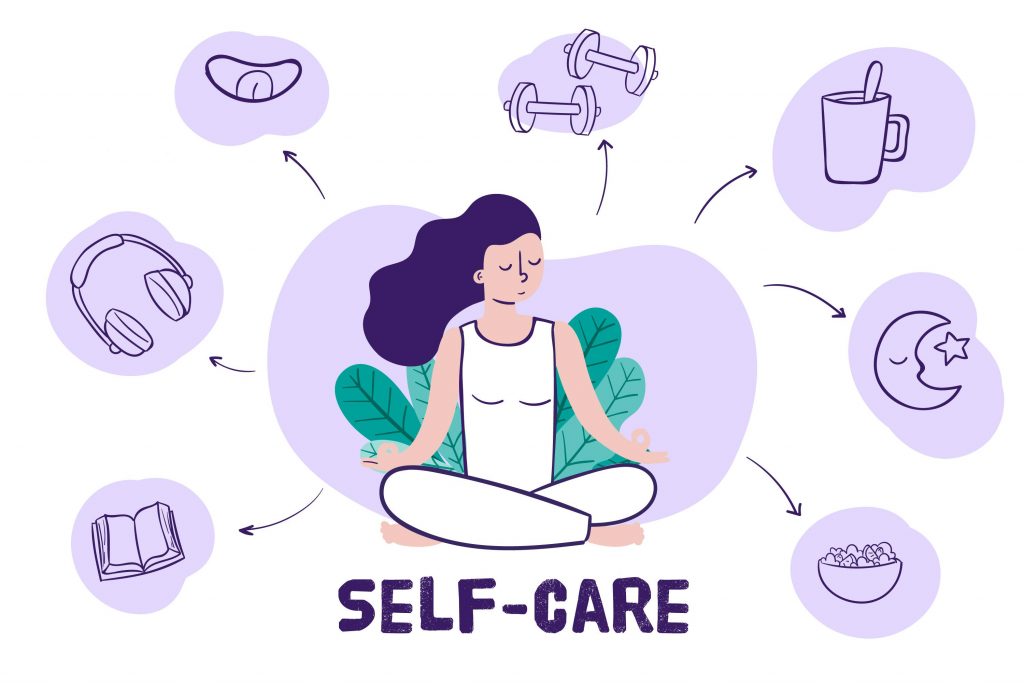
A study published in 2018 took self-care to mean “the self-initiated behavior that people choose to incorporate to promote good health and general well-being.” The study authors added that it’s about being healthy but also about incorporating coping strategies to deal with work stressors.
In 2019, researchers published a framework to specifically point out that in addition to self-care being the activities individuals do on their own to promote physical and emotional health, it also includes the ways that individuals interact with clinicians and healthcare systems to tend to physical and emotional health. That means it includes things like getting a vaccine, scheduling cancer screenings, or taking prescription medications on schedule — but healthcare providers and organizations play a role, too, in how well individuals engage in these practices. In other words: There are a lot of people and factors that bear on any individual’s ability to engage in self-care.
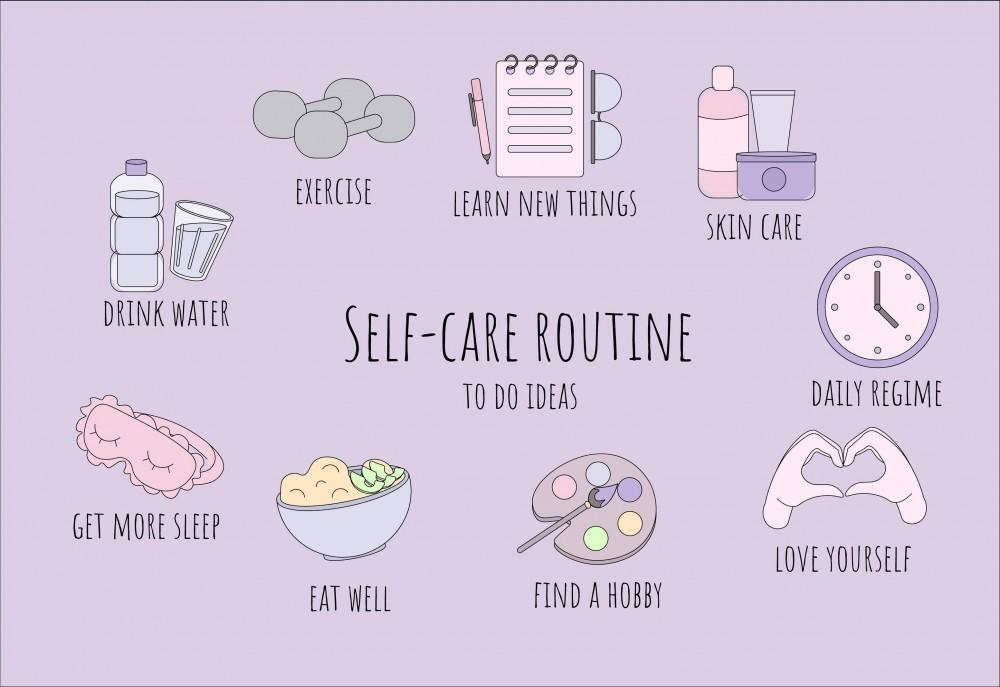
As self-care has become more mainstream, the definitions have started to become more about general wellbeing and tend to focus on tuning in to one’s needs and meeting those needs. “Self-care is anything that you do for yourself that feels nourishing,” says Marni Amsellem, PhD, a licensed psychologist based in the greater New York metropolitan area.
“That can be something that’s relaxing or calming, or it can be something that is intellectual or spiritual or physical or practical or something you need to get done,” she says.
The International Self-Care Foundation also includes health literacy as a pillar of self-care, meaning that any steps you take toward better understanding health information you need to make appropriate decisions about your health and well-being counts as self-care, too.
Self-care requires checking in with yourself and asking yourself how you’re doing physically, mentally, and emotionally. Some people use it to deal with difficult news stories, while others practice it just to maintain their happiness day to day. Self-care does not mean the same thing for everyone. Different people will adopt different self-care practices, and even your own definition might change over time. “What is self-care for one person will likely differ from someone else, and what’s self-care for you one day might not feel like self-care another day,” Dr. Amsellem says.
Engaging in self-care regularly could help you put your best foot forward. “When we are regularly taking care of ourselves, we are better able to react to the things that go on in our lives,” Amsellem says. “It’s something we do to maintain positive well-being.”
Types of Self-Care
“It could be anything that floats your boat — anything that puts a smile on your face,” Dr. Gill Lopez says. “Anything that makes you feel cared for, even if it’s you caring for yourself.”
There are a few different categories of self-care:
- Emotional self-care, such as self-talk, weekly bubble baths, saying “no” to things that cause unnecessary stress, giving yourself permission to take a pause, or setting up a weekly coffee date with a friend
- Physical self-care, such as prioritizing sleep, adopting an exercise routine you can stick with, or choosing healthy and nourishing foods over highly processed ones
- Spiritual self-care, such as attending a religious service, spending time in nature, meditating, incorporating regular acts of kindness into your day, or keeping a gratitude journal
Additionally, Gill Lopez puts self-care into two further categories: temporary and enduring.
What Counts as Self-Care, and What Doesn’t
There’s no way to say exactly what counts as self-care because everyone’s definition is their own and unique.
The underlying rule is that it’s something that brings you sustained joy in the long run. And though there are plenty of examples of self-care that seem to tread a fine line between a health-enhancing behavior and self-indulgence, self-care doesn’t have to be about padding your calendar with luxurious experiences or activities that cost money (though it certainly can).
Consider a manicure or a massage or any other pampering activity. It might seem indulgent, but if the activity helps you de-stress and carve out time for yourself, it counts as self-care, Amsellem says. If weekly manicures or monthly spa days are beyond your means, they will likely add stress to your life in the long run, so there are plenty of other self-care practices you can adopt.
“Self-care does not have to cost anything — it’s just doing things you enjoy. And a lot of the things we enjoy or feel fulfilled from cost nothing,” Amsellem says. “Stepping outside and taking a deep breath, for example, might be the greatest act of self-care.”
Even if you can’t spend lots of time and money, Gill Lopez says you can still practice self-care several times a week by turning things you do every day into self-care practices.
Maybe you try being more mindful of your thoughts on your commute, or maybe you find ways to make daily tasks, like showering, more enjoyable. Pick a soap with a scent that you love, and focus on the physical sensations of the shower. Gill Lopez says: What does your shower smell like? What does it sound like? How does the warm water feel on your skin? “For about 10 minutes in the shower, which I have to do anyway, instead of letting my monkey brain run wild, I’m right there,” she says.
Daily chores like making your bed in the morning are also examples of self-care — or can be. “This is where that individuality comes into play, because for some people there is no way making a bed feels like self-care — it may just feel like a chore,” Amsellem says. But if it helps you claim your day and gives you a sense of accomplishment early on, you’ll have that with you even if the rest of the day gets derailed, Amsellem says.
The simple act of making your bed in the morning likely isn’t sufficient to account for all your self-care, she says. You may need to routinely devote time and energy to other self-care practices, she adds. “But if there are some days when you feel out of control, on those days, starting the day off doing what you wanted to do for yourself might be one of the biggest forms of self-care you engage in that day.”
And sometimes when all of our other self-care plans get thrown out of whack (you worked through your yoga class, your friend canceled your coffee date — we’ve all been there), it’s those small practices of self-care that provide just enough calm to help us get through the day and wake up in a better mood tomorrow.
The Effects: How Self-Care Benefits Your Health and Well-Being
Many common self-care practices have been linked to longevity and other positive health outcomes, says Ellen K. Baker, PhD, a psychologist based in Washington, DC. There’s a lot of research, for example, showing that things like exercise, yoga, and mindfulness are supportive of mental and physical health, she says.
An article published in 2020 noted that longevity in the 21st century depends on abiding by healthy practices — such as exercising, not smoking, and following a healthy diet — and also embracing a positive lifestyle all around. Paying attention to your well-being involves asking yourself big questions (such as “What brings me satisfaction?”) and then finding ways to get there.
The following self-care practices have been well-researched and linked to a longer life:
- Exercise People who exercised between two and eight hours per week throughout their lives reduced their risk of an early death by 29 to 36 percent.
- Finding Purpose According to the researchers behind a 2019 study, having a strong life purpose was associated with decreased mortality rates.
- Diet Eating a diet filled with more servings of fruits and vegetables per day was associated with a lower risk of mortality, especially from heart-related issues.
- Sleep A study published in 2017 found too little sleep (less than seven hours per night) was linked with higher mortality rates, though too much sleep wasn’t healthy either.
- Getting Outside According to a 2019 study, spending time in green space is associated with a lower mortality rate.
The clinical evidence documenting the long-term health benefits of specifically taking a self-care approach to health (over other approaches) is less robust, but it is building.
For instance, research shows that people with chronic conditions who were more likely to follow medication regimens, to be knowledgeable about how to take care of their health, and to have the skills to take care of their health (characteristics that are considered part of self-care) were more likely to score higher when it came to measures of mental and physical functioning.
How to Start a Self-Care Routine
To get started with a self-care routine:
- Determine which activities bring you joy, replenish your energy, and restore your balance.
- Start small by choosing one behavior you’d like to incorporate into your routine in the next week.
- Build up to practicing that behavior every day for one week.
- Reflect on how you feel.
- Add more practices when ready.
- Get support through sharing practices from loved ones, a coach, a licensed professional (like a therapist or dietitian), or through your healthcare plan, community, or workplace.
Practicing self-care doesn’t need to be a heavy lift right out of the gate. Here are a few ideas to ease you into your self-care journey:
- Journal.
- Start each day by paying attention to your breath for five minutes and setting intentions for the day.
- Eat breakfast.
- Reflect on what you’re grateful for each night.
- Put your phone on airplane mode for a half hour before bed each night to release yourself from the flurry of notifications.
- Call a friend just to say hello.
- Take up a relaxing hobby.
- Pick a bedtime, and stick to it.
Note: If you read this and feel a sense of demoralization or sadness from the challenges of mounting or establishing a self-care practice, it’s best to get help and support. There may be barriers to caring for yourself from past trauma, mental health issues, or family situations that may be making it more challenging to get started. Seek support from trusted counselors and behavioral health providers (like a therapist), a trusted primary care doctor, or a close friend.
The bottom line: Self-care can have a positive effect on your health and outlook, but it requires a commitment or intention to invest in your well-being.
Its name makes it sound like a silly playground game, but pickleball has become a seriously popular sport, especially with older adults. Pickleball stretches and exercises are important for your health.
The game, which is played with a paddle on a 20-by-44-foot court, has been described as a combination of tennis, ping pong and badminton. There’s a common misconception that pickleball is not as strenuous as tennis, but it can be, especially if you’re very competitive. Before you play, you still need to take precautions and warm up like you would with any other sport.
For anyone who is new to pickleball and hasn’t been very active, it is advised to slowly ramp up the amount of time spent playing. Cross-training to help to build up cardiovascular endurance, is recommended. Swimming and stationary cycling are both great for older people, because they are easy on the joints.
Even if you take the right pre-game steps, pickleball-related injuries can still happen. Here, we highlight the most frequent pickleball injuries that are seen among physical therapy patients, some exercises and stretches that can help prevent them and how to treat them when they happen.
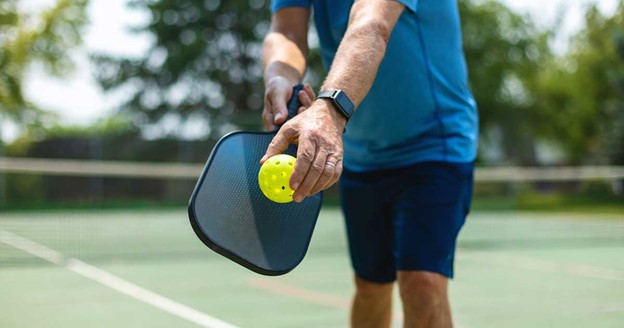
Ankle sprain
Ankle sprains are the most common pickleball injury. Pickleball is similar to tennis in that it requires a lot of running and sudden stopping and a lot of side-to-side movements. If your ankle stabilizer muscles are not strong enough, you increase the risk of twisting your ankle.
If you do twist your ankle, you should ice it as soon as you can. You may also want to wrap it with an elastic bandage or use an ankle support sleeve, which can be purchased at a drugstore. Bandaging it provides compression, which helps keep the swelling down. Elevating the injured ankle can also help, as can taking an over-the-counter pain medication like Tylenol or Advil.
Move to try: Heel Raises
Controlled heel raises help to strengthen your ankles.
- Hold on to a counter or table for balance.
- Stand with your feet about hip-width apart and your toes pointing forward.
- Slowly raise your heels as high as they can go, then lower them just as slowly. Do this several times.
Knee strain
Because pickleball is popular among older people, a lot of players have underlying arthritis in their knees. The twisting and pivoting movements that happen on the court can often aggravate knee arthritis. You may have a sharp, stabbing pain or a momentary feeling of weakness.
Similar to an ankle sprain, if you strain or twist your knee it’s important to bring the inflammation down. Ice and over-the-counter pain medications can help control swelling, and an elastic bandage or knee brace can provide support.
Move to try: Side-Lying Leg Lift
The side-lying leg lift is particularly helpful for preventing knee injuries because it works the entire leg, all the way up to the hip. Building overall leg strength helps protect the knees.
- Lie on your side, then lift your top leg keeping the knee straight and position it slightly behind you. Keep your hips stacked on top of each other and engage your core.
- Slowly lower your leg before lifting it again. If you feel it in your butt — your glutes — you know you’re doing it right.
- Repeat several times, then switch sides.
Pulled hamstring
It’s very important to stretch and warm up your muscles before playing pickleball. The hamstrings, or muscles in the backs of your thighs, may get stretched too far or become strained, especially if you’re not warmed up. These injuries often happen during sudden stops on the court, when the muscles contract quickly.
As with other injuries of the lower extremities, icing the injury and taking over-the-counter pain medications are key to feeling better. With any of these injuries, if the pain persists longer than a week or if you can’t put any weight on the injured leg, you may want to see a healthcare provider.
Move to try: Hamstring Stretch
This warm-up stretches your calves as well as your hamstrings.
- Standing with both feet side by side, extend your left leg in front of you so that your heel is on the ground with your toes pointing up.
- Bend your right knee and hinge at the waist so that your torso angles forward. You should feel a stretch in the back of your thigh.
- Hold for 30 seconds, then switch sides and repeat. Additionally, a slow jog in place can help increase blood flow to the leg muscles before starting a game.
Tendonitis in the wrist, elbow or shoulder
Tendonitis, an inflammation or swelling of the tendons, is an injury caused by overuse. When you hit the ball in pickleball, you don’t use as much force as you do with tennis because the ball is much lighter, but if you’re new to the game or if you’re playing a lot, the repetitive motion can put stress on your tendons.
Especially if you’re just starting out with pickleball and have not regularly played other racquet sports, it’s important to give yourself a day or two of recovery between sessions. Once your muscles get used to the movements, you might be able to play more often.
Similar to injuries in the lower extremities, ice and pain medications can help to reduce inflammation and speed healing. For injuries caused by repetitive motion, rest is especially important in helping your body heal.
Injuries related to falls
When you fall, it’s natural to use your hands to catch yourself. This can result in injuries to the hand, wrist or shoulder. If you have a lot of pain, it’s probably better to see the doctor and get an x-ray sooner rather than later to make sure nothing is broken.
If you fall while playing pickleball, you may also hit your head. If you feel anything out of the ordinary, including blurry vision, a sense of confusion, or extreme sleepiness, it’s important to it checked out to make sure you don’t have a serious injury like a concussion.
Move to try: Single-Leg Balance
The best way to prevent falling is to improve your balance.
- Stand with both feet hip-width apart without holding onto anything for support.
- Lift one foot off the ground. Hold your arms out to the sides if you need help balancing.
- Hold for as long as possible, up to a minute on each side. Once you’ve mastered that, you can try standing on something uneven like a pillow or a folded-up blanket.
YOU CAN DO BY YOURSELF THIS WINTER
Anyone bitten by the pickleball bug knows that half the joy of playing is the community and camaraderie we share with the groups we play with. Even an “off” day on the court is still filled with smiles, laughs, and jokes with our partners and opponents.
For the players in warm locales, there’s no off-season for the pickleball addiction. However, when the winter arrives (or already here) we have to find a way to keep up. While some might be fortunate to have an indoor spot to play weekly, for most of us it means less pickleball- or no pickleball at all! As gut-wrenching as that is to say, it doesn’t mean we can’t use this time to stay sharp and improve our games.
So, here are 4 pickleball drills anyone can do to improve their play during the winter. All of these drills can be modified to the space you do have- whether it be an open room in the basement, a garage door, or braving the cold for some time off the backboard of a local court.
1. WALL DINKS
The first pickleball drill is Wall Dinks. Two observations- 1) every time I watch the pros, I’m stunned at how precise they are and how rarely they come up short on their dinks, and 2) I can’t think of any greater frustration in my own game than when I mis-hit a dink and leave it short! So, what could be a better use of practice time than working on your dinking? If you generally work from home a couple of days a week, in lieu of a post-lunch afternoon walk, on pleasant days, you can start taking your paddle and a ball to a park adjacent to your house with a tennis backboard. Start each session hitting 100 dinks with your forehand and 100 dinks backhand…you’d be amazed at how much it will improve your dinking during games. Add a “target” for increased precision, and it’s stunning how fast you can get a lot of dink work in. As a bonus, when you dink off a wall, you really have to exaggerate bending your knees and getting into your legs or you’ll quickly end up with a sore back.
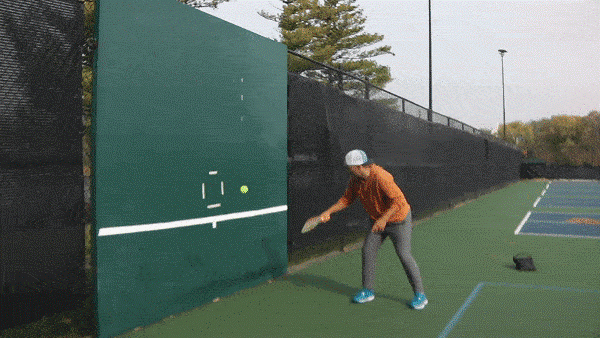
2. WALL VOLLEYS
The second pickleball drill is Wall Volleys. Other than a well-executed Erne or ATP, there’s probably nothing much more satisfying than winning a hands battle at the kitchen line. However, we’d venture to guess that this is one thing that most of us aren’t practicing regularly. Along with the dinking routine noted above, another drill you can take to practicing on lunch breaks is volleying the ball off the wall. Try to get to 100 in a row (which is hard), and generally don’t stop until you at least keep in the air 30 consecutive times. This obviously improves reaction times, but it has the side benefit of reminding us how important it is to keep our paddles up and in a ready position to be prepared to handle quick shots from our opponents. As you get used to it, try alternating between your forehand and backhand so you have to practice moving your paddle quickly across your body
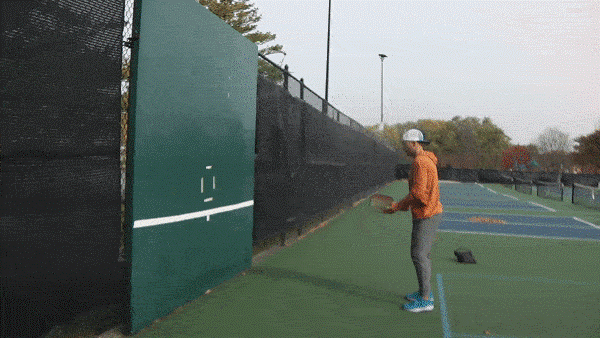
3. SERVE, DRIVE, & DROP
The third pickleball drill is Serve, Drop, & Drive. This one requires a little more space, though you can modify it to make it work in a 20-foot garage. In this drill, hit a sequence of 3 shots- hit a serve at full-speed, then a drive, and follow that up with a drop shot. Hit the serve with some pace, and in doing this drill as part of your park routine, you can really improve your overall accuracy. It’s always good practice to hit these so it’s something you can have “in the bag” when you do need it. It’s also a great reminder of how important it is to move your feet to be in a position to hit a good drive. And we think that we speak for every pickleball player in speaking to the importance of an effective drop shot- we all could stand to practice dropping from the transition zone more often.
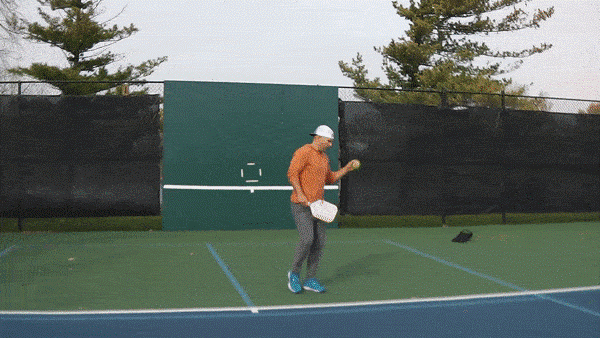
So, as bummed as any of us are to have to take some time away from the pickleball court in the winter months, it doesn’t mean there aren’t things we can do to keep our skills sharp before we can say “0-0-2!” with our pickleball pals again!

